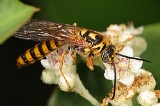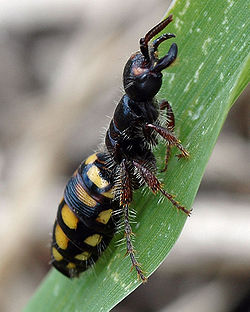
Tiphiidae
Encyclopedia
Tiphiidae is a family
of large solitary wasp
s whose larvae are almost universally parasitoid
s of various beetle
larvae, especially those in the superfamily Scarabaeoidea
.
Most species are small, but they can be up to 30 mm long. The females of some subfamilies (all Brachycistidinae, Diamminae, Methochinae, and Thynninae) are wingless, and hunt ground-dwelling (fossorial
) beetle larvae, or (in one species) mole cricket
s. The prey is paralysed with the female's sting
and an egg is lain upon it so the wasp larva has a ready supply of food. In species where both sexes are winged, males are similar in size to the females, but are much more slender. The males of species with wingless females, however, are often much larger than the females and have wings, the adults mating in the air, with the female carried by the male's genitalia (see photo). Adults feed on nectar and are minor pollinator
s. As some of the ground-dwelling scarab species attacked by tiphiids are pests, some of these wasps are considered beneficial as biological control agents.

Also Wing venation image at http://www.inhs.uiuc.edu/cee/biocontrol/parasites/graphics/tiphiidae.g

Family (biology)
In biological classification, family is* a taxonomic rank. Other well-known ranks are life, domain, kingdom, phylum, class, order, genus, and species, with family fitting between order and genus. As for the other well-known ranks, there is the option of an immediately lower rank, indicated by the...
of large solitary wasp
Wasp
The term wasp is typically defined as any insect of the order Hymenoptera and suborder Apocrita that is neither a bee nor an ant. Almost every pest insect species has at least one wasp species that preys upon it or parasitizes it, making wasps critically important in natural control of their...
s whose larvae are almost universally parasitoid
Parasitoid
A parasitoid is an organism that spends a significant portion of its life history attached to or within a single host organism in a relationship that is in essence parasitic; unlike a true parasite, however, it ultimately sterilises or kills, and sometimes consumes, the host...
s of various beetle
Beetle
Coleoptera is an order of insects commonly called beetles. The word "coleoptera" is from the Greek , koleos, "sheath"; and , pteron, "wing", thus "sheathed wing". Coleoptera contains more species than any other order, constituting almost 25% of all known life-forms...
larvae, especially those in the superfamily Scarabaeoidea
Scarabaeoidea
Scarabaeoidea is a superfamily of beetles, the only subgroup of the infraorder Scarabaeiformia. Around 35,000 species are placed in this superfamily and some 200 new species are described each year...
.
Most species are small, but they can be up to 30 mm long. The females of some subfamilies (all Brachycistidinae, Diamminae, Methochinae, and Thynninae) are wingless, and hunt ground-dwelling (fossorial
Fossorial
A fossorial organism is one that is adapted to digging and life underground such as the badger, the naked mole rat, and the mole salamanders Ambystomatidae...
) beetle larvae, or (in one species) mole cricket
Mole cricket
The mole crickets compose family Gryllotalpidae, of thick-bodied insects about long, with large beady eyes and shovel-like forelimbs highly developed for burrowing and swimming. They can also fly: the adult mole cricket may fly as far as during mating season, is active most of the year, and...
s. The prey is paralysed with the female's sting
Bee sting
A bee sting is strictly a sting from a bee . In the vernacular it can mean a sting of a bee, wasp, hornet, or yellow jacket. Some people may even call the bite of a horse-fly a bee sting...
and an egg is lain upon it so the wasp larva has a ready supply of food. In species where both sexes are winged, males are similar in size to the females, but are much more slender. The males of species with wingless females, however, are often much larger than the females and have wings, the adults mating in the air, with the female carried by the male's genitalia (see photo). Adults feed on nectar and are minor pollinator
Pollinator
A pollinator is the biotic agent that moves pollen from the male anthers of a flower to the female stigma of a flower to accomplish fertilization or syngamy of the female gamete in the ovule of the flower by the male gamete from the pollen grain...
s. As some of the ground-dwelling scarab species attacked by tiphiids are pests, some of these wasps are considered beneficial as biological control agents.

Family description
See http://delta-intkey.com/britin/hym/www/tiphiida.htmAlso Wing venation image at http://www.inhs.uiuc.edu/cee/biocontrol/parasites/graphics/tiphiidae.g

External links
- Myzinum maculata Fabricius, a tiphiid wasp on the UFUniversity of FloridaThe University of Florida is an American public land-grant, sea-grant, and space-grant research university located on a campus in Gainesville, Florida. The university traces its historical origins to 1853, and has operated continuously on its present Gainesville campus since September 1906...
/ IFASInstitute of Food and Agricultural SciencesThe University of Florida’s Institute of Food and Agricultural Sciences is a federal-state-county partnership dedicated to developing knowledge in agriculture, human and natural resources, and the life sciences, and enhancing and sustaining the quality of human life by making that information...
Featured Creatures Web site

